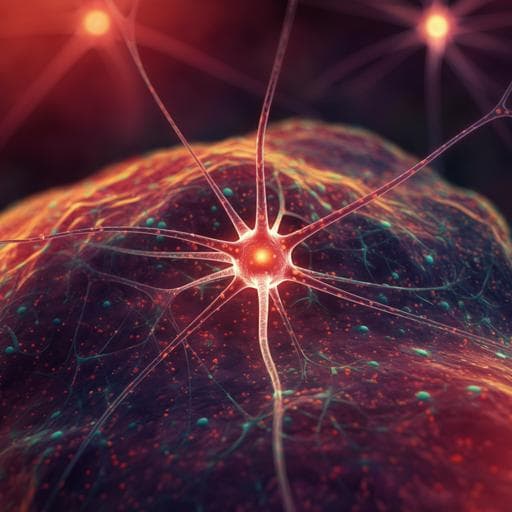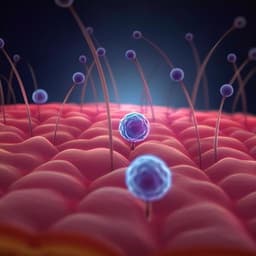
Medicine and Health
Single-cell genomic profiling of human dopamine neurons identifies a population that selectively degenerates in Parkinson's disease
T. Kamath, A. Abdulraouf, et al.
This groundbreaking study by Tushar Kamath, Abdulraouf Abdulraouf, and colleagues reveals crucial insights into the vulnerability of dopamine neurons in Parkinson's disease. By profiling over 387,000 nuclei, researchers uncovered a specific neuron population that is particularly susceptible to degeneration, highlighting significant genetic risks tied to this subtype. This research sheds light on the intrinsic mechanisms behind neuron loss in PD, a critical step towards understanding and treating the disease.
~3 min • Beginner • English
Introduction
Degeneration of midbrain dopaminergic neurons in the substantia nigra pars compacta (SNpc) is a hallmark of Parkinson's disease (PD) and Lewy body dementia (LBD). Despite widespread loss, some SNpc DA neurons survive into late disease stages, suggesting differential vulnerability. Identifying molecular characteristics underlying this vulnerability could refine PD models and guide development of disease-modifying or cell-type-specific therapies. Advances in single-cell RNA sequencing have revealed cell-type-specific changes in brain diseases, but prior human SNpc studies sampled few DA neurons, limiting power to define molecular subpopulations and compare across subjects. To address these gaps, the authors developed an enrichment protocol to selectively capture DA neuron nuclei from postmortem human SNpc, enabling single-nucleus RNA-seq (snRNA-seq) to define DA subtypes and assess their spatial localization and disease-associated vulnerability.
Literature Review
The study builds on prior single-cell and single-nucleus transcriptomic analyses showing cell-type-specific alterations in neurodegenerative and neuropsychiatric disorders. Earlier human SNpc profiling at single-cell resolution reported low yields of DA neurons compared with murine SNpc, hindering robust subtype resolution. Classical neuropathology established dorsal and ventral tiers of A9 DA neurons, with the ventral tier more vulnerable in PD. Recent primate studies suggest overall conservation of cell types with some primate-specific specializations. The authors reference GWAS showing heritable PD risk enrichment in neuronal gene sets, contrasting with Alzheimer's disease where microglia show strong enrichment, framing the question of whether genetic risk in PD is preferentially acting within DA neuronal subtypes.
Methodology
- Tissue and nuclei preparation: Postmortem human midbrain (SNpc) and dorsal striatum tissues were flash-frozen, cryosectioned, and pigmented midbrain regions microdissected. Single-nucleus suspensions were generated using extraction and wash buffers under cold conditions.
- DA neuron enrichment: Fluorescence-activated nuclei sorting (FANS) using an NR4A2 (NURR1) antibody (AF647) and DAPI gating enriched DA nuclei. The NR4A2-positive gate selected the top ~2.5–4% most fluorescent nuclei, yielding ~70-fold enrichment of DA neurons.
- snRNA-seq: Libraries were prepared using 10x Genomics 3' v3 chemistry and sequenced (NextSeq/NovaSeq). Initial profiling of eight neurotypical donors produced 184,673 high-quality profiles (median per cell ~8,086 UMIs and 3,462 genes). Combined with disease cohorts, the study sampled 387,483 nuclei total, including 22,048 DA neuron profiles.
- Clustering and integration: Major cell classes were identified via Seurat-like workflows; non-neuronal cells were integrated with Harmony. DA neurons were subclustered using LIGER (integrative non-negative matrix factorization), yielding a low-dimensional embedding and clustering into ten DA subtypes. Alignment across donors was high (alignment score 0.98). Cross-method validation with Harmony confirmed subtype structure.
- Cross-species analysis: DA neurons from four additional species (macaque, tree shrew, rat, mouse) were integrated via LIGER projection to assess conservation and identify primate-specific subtypes.
- Spatial transcriptomics: Slide-seqV2 was performed on 27 arrays from nine coronal sections of Macaca fascicularis SNpc. Robust cell type decomposition (RCTD) mapped snRNA-seq-defined DA subtypes to Slide-seq beads to determine dorsal–ventral localization relative to CALB1/ALDH1A1 expression boundaries.
- Regulon and TF analysis: SCENIC identified subtype-specific regulons in human and macaque DA neurons. Gene set enrichment analysis (GSEA; fgsea) of known TF target sets on differential expression ranked lists nominated TF programs altered in disease.
- PD/LBD case-control profiling: Additional 202,810 high-quality nuclei (including 6,364 DA neurons) from 10 PD/LBD donors and age/PMI-matched controls were profiled and integrated with controls (68 subpopulations across seven major classes; median alignment score 0.76). Differential abundance used MASC (mixed-effects association of single cells), modeling sex, disease status, NR4A2 enrichment, with library as random effect.
- In situ validation: smFISH using hybridization chain reaction probed TH/SOX6/AGTR1 and TH/CALB1/TMEM200A on 20 additional midbrains (10 PD, 10 control), counting 5,339 DA neurons across 40 SNpc sections to quantify subtype proportions.
- Genetic enrichment: Familial PD genes (n=26) were tested for enrichment across major cell-type marker sets (Fisher’s exact). Common variant enrichment used MAGMA and stratified LD score regression (s-LDSC) on marker gene sets for major classes and 68 SNpc subpopulations. GO enrichment used EnrichR on prioritized genes.
- Differential expression: MAST mixed-effect hurdle models assessed disease effects and subtype markers, controlling for UMIs, sex, mitochondrial read fraction, library, and status.
Key Findings
- DA subtype taxonomy: Ten transcriptionally distinct human SNpc DA subpopulations were identified with strong donor alignment. A major axis separated SOX6+ (four clusters) and CALB1+ (six clusters) neurons, consistent with developmental programs. All subtypes expressed core DA neurotransmission genes (TH, SLC6A3, SLC18A2).
- Cross-species conservation and primate-specific subtype: Eight conserved DA clusters emerged across five species. A primate-specific DA subtype (CALB1_GEM; DA8 in cross-species analysis) was observed only in human and macaque and absent in rodents (no Fam83b or Gem expression in murine DA neurons by in situ).
- Spatial localization: Slide-seqV2 mapping in macaque localized SOX6_AGTR1 cells to the ventral tier (mean relative distance +490 µm), while CALB1_GEM and CALB1_TRHR localized dorsally (−478 µm and −288 µm, respectively). smFISH in human midbrain confirmed ventral localization of SOX6_AGTR1 and dorsal localization of CALB1_GEM and CALB1_TRHR.
- Differential vulnerability in PD/LBD: Among major classes, DA neurons had the largest proportional decline in PD/LBD. Of 68 subpopulations, 11 showed significant changes. The SOX6_AGTR1 DA subtype had the strongest decline, while CALB1_GEM and CALB1_TRHR were proportionally increased. Microglia expressing GPNMB and VIM_LHX2 astrocytes increased, suggesting reactive states.
- smFISH validation: In 20 midbrains, CALB1+/TMEM200A+ DA cells were enriched in PD (P < 0.05), and SOX6+/AGTR1+/TH+ cells were selectively depleted (P < 0.05), with a log(fold change) of approximately −2.1 for SOX6_AGTR1.
- Genetic risk enrichment: Familial PD genes (n=26) were significantly enriched only in DA neuron markers (Bonferroni-corrected P < 0.05). For common variant risk, DA neurons showed strong enrichment for PD heritability, while AD heritability was enriched in microglia/macrophages. Across 68 SNpc subpopulations, SOX6_AGTR1 had the largest and only statistically significant enrichment of PD genetic risk by both MAGMA and s-LDSC (Bonferroni-corrected P < 0.05), independent of nuclei counts per subtype and gene set size.
- Candidate genes and pathways: PD-prioritized genes enriched in SOX6_AGTR1 included WNT3 and IGSF9B; broadly expressed risk genes included SNCA, MAPT, and GAK. GO terms among SOX6+ enriched risk genes highlighted regulation of neuron death and Wnt signaling. GSEA of TF targets in SOX6_AGTR1 revealed upregulation of TP53 and NR2F2 target sets and depletion of LMX1A targets; TP53 transcript was specifically upregulated in SOX6_AGTR1.
Discussion
The study directly addresses the question of which DA neuron subtypes are intrinsically vulnerable in PD by generating a comprehensive human SNpc DA taxonomy, spatially mapping subtypes, and quantifying disease-associated changes. The ventrally localized SOX6_AGTR1 population is disproportionately lost in PD/LBD and uniquely enriched for common PD genetic risk, supporting a model in which PD heritability acts within the most vulnerable DA neurons to influence survival. This contrasts with the microglia-centric enrichment observed for AD, underscoring disease-specific cellular etiologies. The identification of TP53- and NR2F2-regulated stress pathways selectively upregulated in vulnerable SOX6_AGTR1 neurons implicates canonical stress and mitochondrial dysfunction programs in degeneration. The discovery of a primate-specific dorsal-tier CALB1_GEM population, potentially tied to primate-expanded circuitry, illustrates evolutionary divergence relevant to disease resistance. These findings refine targets for mechanistic studies, cellular modeling, and potential therapeutic intervention focused on cell-intrinsic pathways in the most at-risk DA neurons.
Conclusion
This work provides a high-resolution molecular taxonomy of human SNpc DA neurons, localizes subtypes within SNpc architecture, and identifies the SOX6_AGTR1 subtype as highly vulnerable in PD. The convergence of selective degeneration, spatial ventral localization, and strong enrichment of PD genetic risk within SOX6_AGTR1 supports a primarily cell-intrinsic mechanism of vulnerability. The study also delineates altered gene programs—upregulated TP53 and NR2F2 targets and reduced LMX1A targets—within vulnerable neurons. These insights enable refined in vitro differentiation and disease modeling of DA subtypes, inform biomarker development, and prioritize therapeutic strategies targeting stress and mitochondrial pathways. Future directions include validating projection and functional properties of the primate-specific CALB1_GEM population, extending single-cell profiling to additional PD-affected regions to chart the sequence of vulnerability, and experimentally testing modulation of TP53/NR2F2 pathways in subtype-specific models.
Limitations
- Enrichment bias: DA nuclei were enriched using NR4A2 protein, which is downregulated in PD; although smFISH was used to validate subtype proportions independent of NR4A2, initial capture could still bias representation.
- Single-nucleus modality: snRNA-seq profiles nuclear RNA and may under-represent cytoplasmic transcripts; dissociation artifacts were noted (for example, SOX6_DDT showed elevated oxidative phosphorylation and ER-associated RNAs), though such clusters were considered in analyses.
- Spatial mapping species: High-resolution spatial localization of DA subtypes via Slide-seqV2 was performed in macaque SNpc, with human localization validated by smFISH; comprehensive human spatial transcriptomics was not performed.
- Sample size and heterogeneity: While large for postmortem studies, certain subtypes had limited nuclei, and alignment scores across the integrated case-control datasets varied; robustness checks were performed but residual batch or sampling effects cannot be fully excluded.
- Cross-sectional design: Postmortem snapshots limit inference on temporal dynamics of degeneration and causality of transcriptional changes.
Related Publications
Explore these studies to deepen your understanding of the subject.







